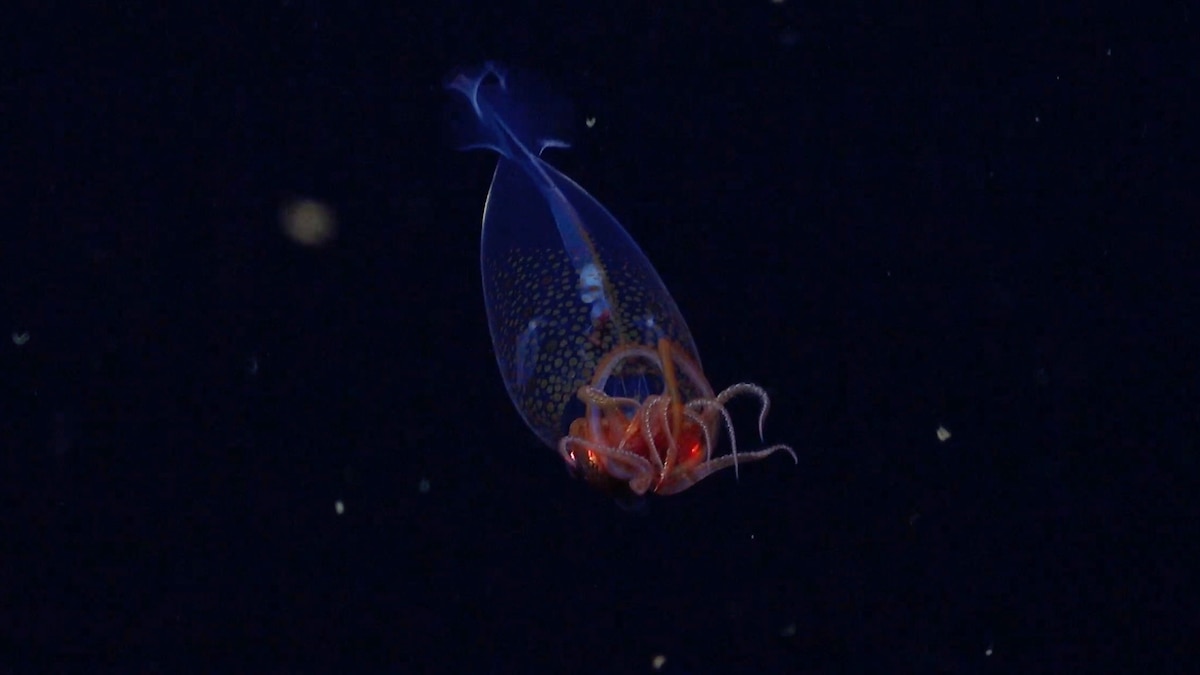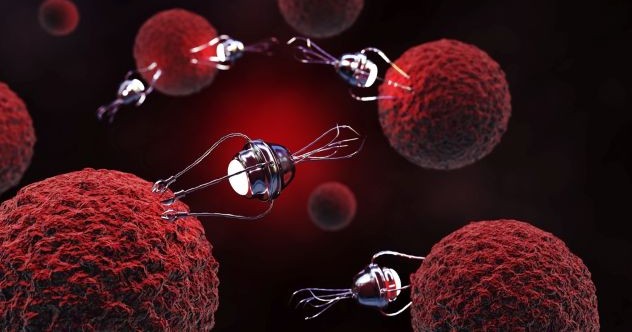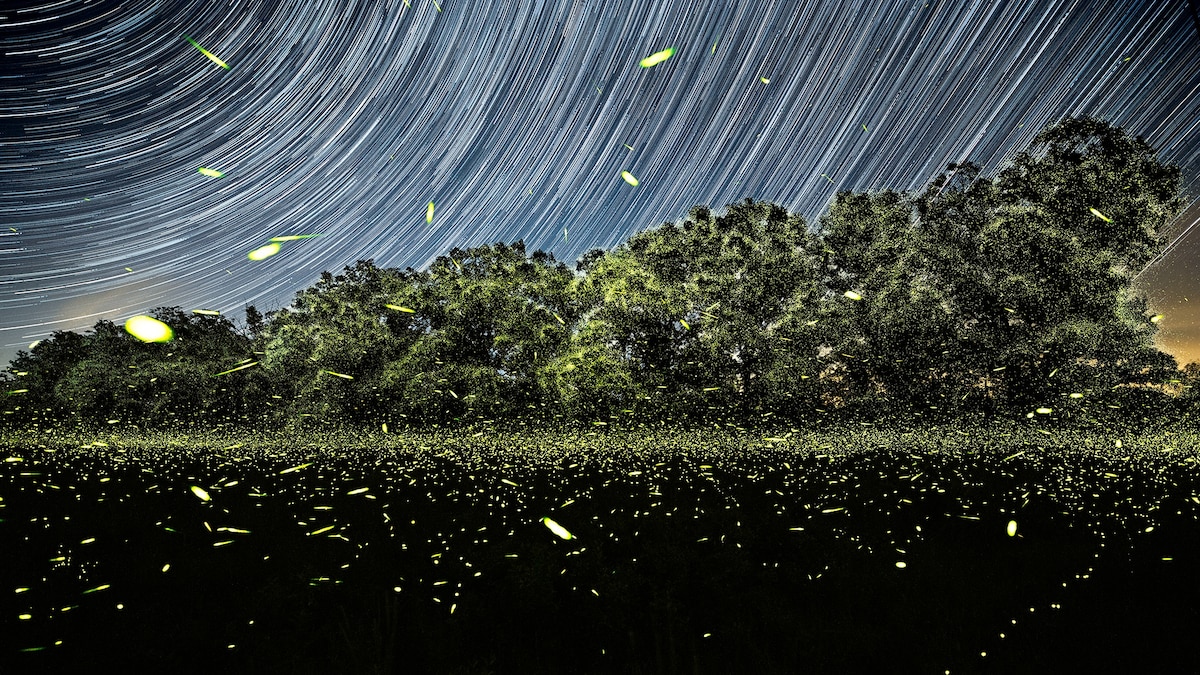Now Reading: In a surprising deep sea first, a colossal squid is caught on camera
-
01
In a surprising deep sea first, a colossal squid is caught on camera
In a surprising deep sea first, a colossal squid is caught on camera

The colossal squid—one of nature’s most elusive animals, and handily the world’s most massive squid species—was first identified 100 years ago using remains found in the stomach of a sperm whale. Now, for the very first time, one has been filmed alive in its natural oceanic environment.
On March 9, the U.S.-based Schmidt Ocean Institute’s research vessel, Falkor (too), was exploring the frigid waters close to the South Sandwich Islands, in the southern Atlantic Ocean, as part of an international quest to discover marine life. That day, they deployed a remotely operated submersible down to a depth of almost 2,000 feet, when the colossal squid suddenly drifted past the submersible’s cameras.
After making sure to verify the footage with a series of experts both on and off the research cruise, scientist came to a startling conclusion: “This is the first confirmed footage of the colossal squid at home in the deep sea,” says Kat Bolstad, a squid expert at the Auckland University of Technology.
These animals are estimated to grow up to 23 feet or so in length and weigh around 1,100 pounds, but this colossal squid was no more than a foot long. This led scientists to another surprising takeaway.
“This is not the giant animal we’d expect the colossal squid to be,” says Aaron Evans, an independent scientist and glass squid expert. “It’s not a baby either.” Based on the mid-developmental stage of its physical features, “we can think of this as maybe a teenage squid.”
Until now, all knowledge about this usually ginormous animal had been pieced together from those early sperm whale stomach segments, and a handful of deceased colossal squid accidentally caught by fishing expeditions. Now that one has been glimpsed on camera, several theories about the behavior and biology of this species can be tested.
“This is honestly one of the most exciting observations we’ve had” in the history of the field, says Bolstad.

This colossal squid was described as a “teenager” by one squid expert, showing the early signs of adult characteristics but only a fraction of its eventual 20-foot-long and 1,000 pound size.
Photograph By ROV SuBastian / Schmidt Ocean Institute
A colossal puzzle throughout history
Colossal squid belong to the family Cranchiidae and are often referred to as ‘glass squids’.
Living in the dimly lit twilight zone of the sea, they often appear transparent, which helps them avoid predators and ambush prey. They accomplish this thanks to pigment sacs named chromatophores, which they often keep closed. Any remaining opaque body parts are obscured by light organs called photophores, which can glow by matching the level of sunlight trickling down from the surface.
The colossal squid is easily the most mysterious of the 60 known species of glass squid. It was first discovered in 1925 when the marine biologist James Erik Hamilton found two large arm crowns in the stomach of a sperm whale near the Shetland Islands. The pieces were sent back to London’s British Museum, where they were formally identified as a new species that same year.
Then, in 1981, the crew of the Soviet trawler Eureka, inadvertently snagged a nearly 17-foot colossal squid in one of their nets. This specimen, which quickly perished, was not thought to be fully grown. Then, in 2003, a dead colossal squid was found floating off New Zealand’s south coast—this time, 20 feet long.
Footage of a living colossal squid briefly caught on a fishing line emerged in 2005, from a boat in southern Atlantic Ocean waters. And in 2007, a living specimen found itself accidentally ensnared (and fatally injured) by another fishing boat, this time in the Ross Sea, near Antarctica. This 2007 squid, 30 feet in length, appeared to be a fully grown adult.
Although never visually confirmed in its true habitat— deep, open waters around Antarctica and in the Southern Ocean—this handful of largely intact samples have allowed scientists to piece together some key facts (or at least, reasonable assumptions) about the colossal squid.
“We know it’s the heaviest invertebrate on the planet,” says Bolstad. Younger colossal squid hang out at shallower depths. As they age and rapidly grow, they probably descend into the abyss.
You May Also Like
They appear to prey on large sub-Antarctic fish, including Chilean sea bass and other squids, using their unique set of tentacles. Each of the eight sucker-covered arms has a pair of large immobile hooks midway along their length; two of the longer tentacles have fully rotatable hooks at their ends.
Despite what their name may suggest, colossal squid aren’t apex predators: elephant seals, penguins, and other fishes eat juveniles, while sperm whales and sleeper sharks eat younglings and adults—although the scars on several sperm whales suggest these squid put up a hell of a fight. Fortunately, equipped with the largest eyes on the planet, it is able to spot whale-sized predators from a considerable distance.
A deep sea discovery 100 years in the making
But deceased specimens and scattershot footage at the sea surface can only tell you so much. To properly understand the lives of these fascinating animals, scientists needed to spot one swimming through the depths.
Any submersibles hoping to spot them were in for a challenge. Thanks to their giant eyes and wary natures, “They know we are there long before we know they are there,” says Bolstad. “They are actively avoiding us.”
It seems as if Falkor (too)—a research vessel known for its prolific discoveries of marine life —was finally up to the task.
In March, scientists aboard the boat launched SuBastian, an underwater robotic explorer that’s able to dive to almost three miles below the surface. Controlling it via a tether and making sure to equip it with a low-light system that would conceal it from any suspicious squids, it was able to catch a teenage colossal squid on camera hanging out 2,000 feet below the waves.
“It was beautiful, and unusual,” says Michelle Taylor, a deep-sea ecologist at University of Essex and leader of the Falkor (too)’s Ocean Census flagship expedition. Her team quickly beamed the high-resolution footage to Bolstad and Evans, who spied telltale features of the colossal squid—including its unusual hook arrangement on its arms.
“We got very excited, and we started hyperventilating,” says Evans.
The footage is still being heavily scrutinized, but several theories about the colossal squid are already being confirmed.
Scientists could see chromatophores on the juvenile, those color-changing sacs found on other glass squid. That means “it almost certainly can switch back and forth between being completely transparent, which is how we see it mostly in this footage, to being opaque—and it probably has fine control over whether it can do that in certain regions of the body as well,” says Bolstad.
The crew of the Falkor (too) was fortunate enough to get two squid revelations for the price of one. In January, while on another mission to see what life may exist on a newly exposed, glacier-free patch of the Antarctic Peninsula’s seafloor, SuBastian caught another remarkable sight: that of the glacial glass squid, (Galiteuthis glacialis), another species that, until now, had never been documented living in its presumed natural habitat. It was seen gracefully dangling its arms above its head— a pose common to other glass squids— at a depth of 2,250 feet.
These discoveries illustrate that our common perception of the deep, and its denizens, is often skewed toward the frightening and ominous.
“Our idea of the deep sea is a little bit distorted,” says Thom Linley, the Curator of Fishes at the Museum of New Zealand Te Papa Tongarewa. Thanks to some clever engineering, and a little bit of luck, we are finding out that “deep-sea animals are really fragile, and really beautiful.”























